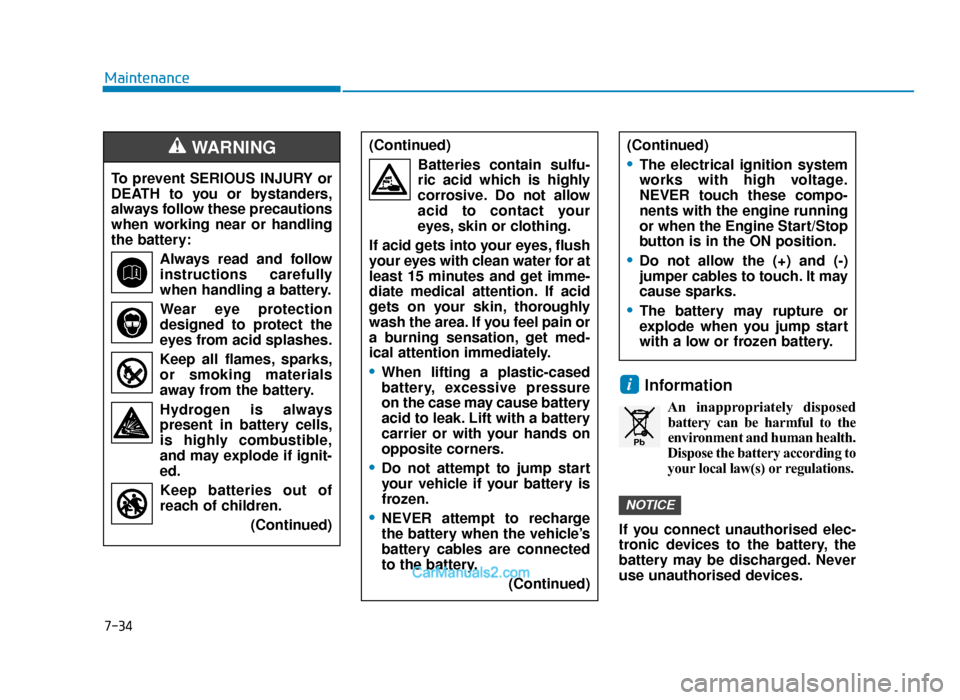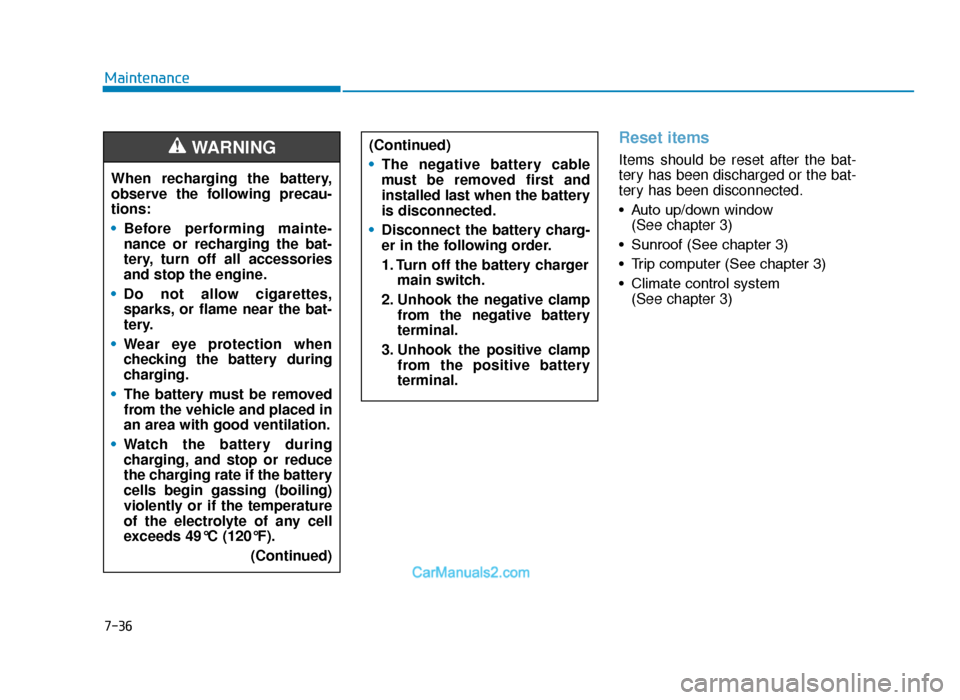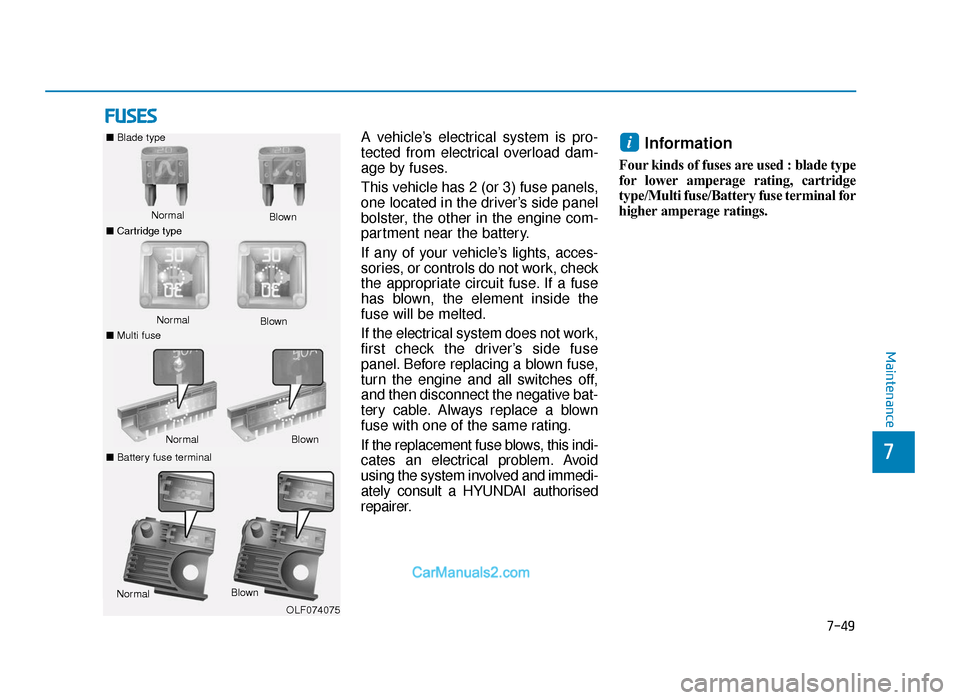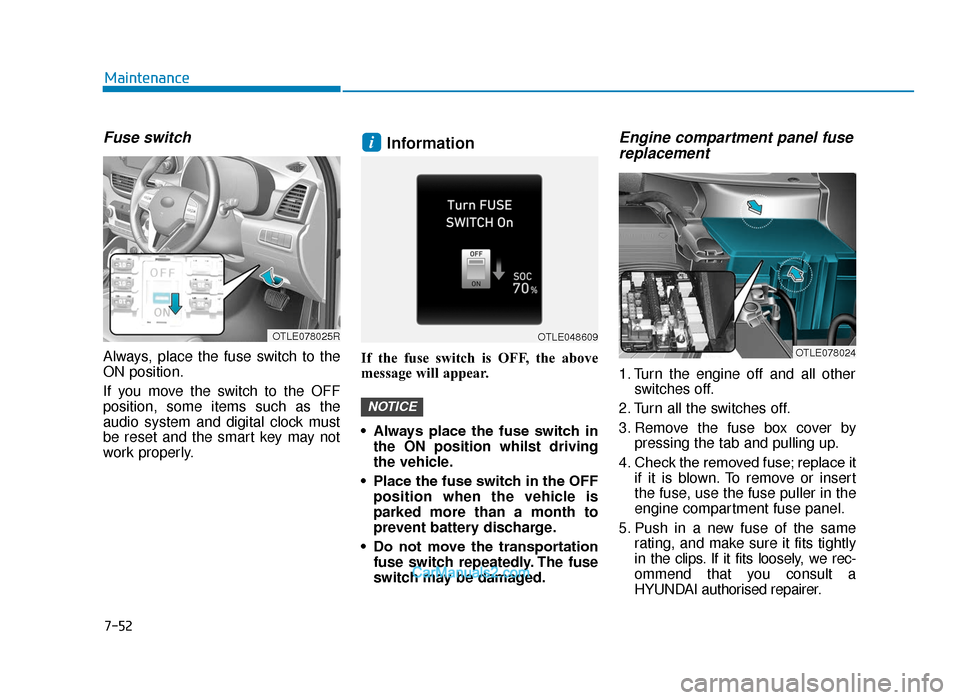Page 583 of 685

7-34
Maintenance
Information
An inappropriately disposedbattery can be harmful to the
environment and human health.
Dispose the battery according to
your local law(s) or regulations.
If you connect unauthorised elec-
tronic devices to the battery, the
battery may be discharged. Never
use unauthorised devices.
NOTICE
i
(Continued) Batteries contain sulfu-
ric acid which is highly
corrosive. Do not allow
acid to contact your
eyes, skin or clothing.
If acid gets into your eyes, flush
your eyes with clean water for at
least 15 minutes and get imme-
diate medical attention. If acid
gets on your skin, thoroughly
wash the area. If you feel pain or
a burning sensation, get med-
ical attention immediately.
•When lifting a plastic-cased
battery, excessive pressure
on the case may cause battery
acid to leak. Lift with a battery
carrier or with your hands on
opposite corners.
•Do not attempt to jump start
your vehicle if your battery is
frozen.
•NEVER attempt to recharge
the battery when the vehicle’s
battery cables are connected
to the battery. (Continued)
(Continued)
•The electrical ignition system
works with high voltage.
NEVER touch these compo-
nents with the engine running
or when the Engine Start/Stop
button is in the ON position.
•Do not allow the (+) and (-)
jumper cables to touch. It may
cause sparks.
•The battery may rupture or
explode when you jump start
with a low or frozen battery.
Pb
To prevent SERIOUS INJURY or
DEATH to you or bystanders,
always follow these precautions
when working near or handling
the battery:Always read and follow
instructions carefully
when handling a battery.Wear eye protection
designed to protect the
eyes from acid splashes.
Keep all flames, sparks,
or smoking materials
away from the battery.
Hydrogen is always present in battery cells,
is highly combustible,
and may explode if ignit-
ed.
Keep batteries out of
reach of children.
(Continued)
WARNING
TLe UK 7.qxp 5/10/2018 1:34 PM Page 34
Page 585 of 685

7-36
Maintenance
Reset items
Items should be reset after the bat-
tery has been discharged or the bat-
tery has been disconnected.
• Auto up/down window (See chapter 3)
• Sunroof (See chapter 3)
• Trip computer (See chapter 3)
• Climate control system (See chapter 3)
(Continued)
•
The negative battery cable
must be removed first and
installed last when the battery
is disconnected.
• Disconnect the battery charg-
er in the following order.
1. Turn off the battery charger
main switch.
2. Unhook the negative clamp from the negative battery
terminal.
3. Unhook the positive clamp from the positive battery
terminal.
When recharging the battery,
observe the following precau-
tions:
•Before performing mainte-
nance or recharging the bat-
tery, turn off all accessories
and stop the engine.
• Do not allow cigarettes,
sparks, or flame near the bat-
tery.
• Wear eye protection when
checking the battery during
charging.
• The battery must be removed
from the vehicle and placed in
an area with good ventilation.
• Watch the battery during
charging, and stop or reduce
the charging rate if the battery
cells begin gassing (boiling)
violently or if the temperature
of the electrolyte of any cell
exceeds 49°C (120°F).
(Continued)
WARNING
TLe UK 7.qxp 5/10/2018 1:34 PM Page 36
Page 598 of 685

7-49
7
Maintenance
FUSES
A vehicle’s electrical system is pro-
tected from electrical overload dam-
age by fuses.
This vehicle has 2 (or 3) fuse panels,
one located in the driver’s side panel
bolster, the other in the engine com-
partment near the battery.
If any of your vehicle’s lights, acces-
sories, or controls do not work, check
the appropriate circuit fuse. If a fuse
has blown, the element inside the
fuse will be melted.
If the electrical system does not work,
first check the driver’s side fuse
panel. Before replacing a blown fuse,
turn the engine and all switches off,
and then disconnect the negative bat-
tery cable. Always replace a blown
fuse with one of the same rating.
If the replacement fuse blows, this indi-
cates an electrical problem. Avoid
using the system involved and immedi-
ately consult a HYUNDAI authorised
repairer.Information
Four kinds of fuses are used : blade type
for lower amperage rating, cartridge
type/Multi fuse/Battery fuse terminal for
higher amperage ratings.
i■Blade type
Normal
■ Cartridge type Blown
Normal
Blown
■ Multi fuse
Normal Blown
■
Battery fuse terminal
Normal Blown
OLF074075
TLe UK 7.qxp 5/10/2018 1:35 PM Page 49
Page 600 of 685
7-51
7
Maintenance
Inner panel fuse replacement
1. Turn the engine and all otherswitches off.
2. Open the fuse panel cover. 3. Pull the suspected fuse straight
out. Use the removal tool provided
in the engine compartment fuse
panel.
4. Check the removed fuse; replace it if it is blown.
5. Push in a new fuse of the same rating, and make sure it fits tightly
in the clips.
If it fits loosely, we recommend that
you consult a HYUNDAI authorised
repairer.
Information
If you do not have a spare, use a fuse
of the same rating from a circuit you
may not need for operating the vehi-
cle, such as the cigar lighter fuse.
If the headlights or other electrical
components do not work and the
fuses are OK, check the fuse block in
the engine compartment. If a fuse is
blown, it must be replaced with the
same rating.
i
OTLE078026
OTLE078023R
TLe UK 7.qxp 5/10/2018 1:35 PM Page 51
Page 601 of 685

7-52
Maintenance
Fuse switch
Always, place the fuse switch to the
ON position.
If you move the switch to the OFF
position, some items such as the
audio system and digital clock must
be reset and the smart key may not
work properly.
Information
If the fuse switch is OFF, the above
message will appear.
• Always place the fuse switch inthe ON position whilst driving
the vehicle.
• Place the fuse switch in the OFF position when the vehicle is
parked more than a month to
prevent battery discharge.
• Do not move the transportation fuse switch repeatedly. The fuse
switch may be damaged.
Engine compartment panel fusereplacement
1. Turn the engine off and all other switches off.
2. Turn all the switches off.
3. Remove the fuse box cover by pressing the tab and pulling up.
4. Check the removed fuse; replace it if it is blown. To remove or insert
the fuse, use the fuse puller in the
engine compartment fuse panel.
5. Push in a new fuse of the same rating, and make sure it fits tightly
in the clips. If it fits loosely, we rec-
ommend that you consult a
HYUNDAI authorised repairer.
NOTICE
i
OTLE048609
OTLE078024
OTLE078025R
TLe UK 7.qxp 5/10/2018 1:35 PM Page 52
Page 602 of 685
7-53
7
Maintenance
After checking the fuse box in the
engine compartment, securely
install the fuse box cover. If not,
electrical failures may occur from
water leaking in.
Main fuse
If an electrical system does not oper-
ate with no blown fuse in the engine
room and inner fuse box, the main
fuse inside the battery (+) cap may
be blown.
The main fuse is heavily connected
to many other parts. In this case, we
recommend you to contact a
HYUNDAI authorised repairer.
Multi fuse
If the multi fuse is blown, it must be
removed as follows:
1. Disconnect the negative batterycable.
2. Remove the nuts shown in the pic- ture above.
3. Replace the fuse with a new one of the same rating.
4. Reinstall in the reverse order of removal.
Information
If the multi fuse is blown, we recom-
mend that you consult a HYUNDAI
authorised repairer.
i
NOTICE
OTLE078027OTLE078028
TLe UK 7.qxp 5/10/2018 1:35 PM Page 53
Page 608 of 685
7-59
7
Maintenance
Engine compartment fuse panel
Inside the fuse/relay box covers, you
can find the fuse/relay label describ-
ing fuse/relay name and capacity.
Information
Not all fuse panel descriptions in this
manual may be applicable to your
vehicle. It is accurate at the time of
printing. When you inspect the fuse
box on your vehicle, refer to the fuse
box label.
i
OTLE078029
OTLE078030
TLe UK 7.qxp 5/10/2018 1:36 PM Page 59
Page 609 of 685
7-60
Maintenance
Engine compartment main fuse panel (Petrol Engine)
Fuse Name SymbolFuse ratingCircuit Protected
MULTIFUSE
POWER
STEERING111100AMDPS Unit
POWER
STEERING21280AMDPS Unit
B+ 1 60A Smart Junction Block (IPS1, IPS2, IPS3, IPS4, Fuse - F50)
B+ 2 60A Smart Junction Block (IPS5, IPS6, IPS7, IPS8, IPS9, Fuse - F19/F28/F35/F42)
B+ 3 50A Smart Junction Block (Fuse - F23/F32/F39/F41/F46/F48, Power Window Relay)
ABS 1 40A ESP Control Module, ABS Control Module
ABS 2 40A ESP Control Module, ABS Control Module
IG1 40A W/O Smart Key : Ignition Switch, With Smart Key : PCB Block (PDM (IG1) Relay,
PDM (ACC) Relay)
IG2 30A W/O Smart Key : Ignition Switch, With Smart Key : PCB Block (PDM (IG2) Relay)
FUSE
B+ 4 50A Smart Junction Block (Fuse - F14/F21/F22/F31/F38/F45, Leak Current Autocut
Device)
COOLING FAN1(50A)[60A](G4NA/G4FD/G4KJ) : E/R Junction Block (RLY. 1, RLY. 9)
(G4FJ) : E/R Junction Block (RLY. 1)
TLe UK 7.qxp 5/10/2018 1:37 PM Page 60